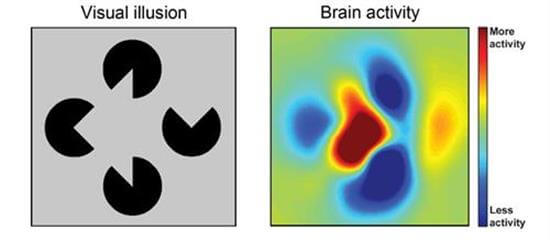
Understand attention and focus better
At this moment, you are not as fully focused as you might think you are. It doesn’t even matter what it is you are doing, your attention is always somewhere else. Whether you are reading modern poetry or making an omelette, you are not, not ever, doing so 100% focused.
Attention
Attention is limited, and focusing can cause us to be unaware of other stimuli around us. Let’s say you are concentrating on learning a new riff on your guitar; you are not noticing the feeling of your shoes on your feet. Neither are you hearing the buzzing noises coming from the streets outside. As we’ve previously learned you basics about the brain, lets put the focus on attention with this one.
New research published in Current Biology has revealed that our attention performs something of an automatic, constant background scan to free up neurons in case they might be needed, enabling us to pay attention when needed.
That is why we can react to sudden changes in our environments, so when somebody yells “BALL!” in your direction, you can adapt to this new incoming, potential, action and attempt to catch it.
It is probably the reason all of us respond when someone you were previously not paying attention to says your name, and immediately you are shifting your attention towards the conversation. Something known as the cocktail party effect.
Feel the rhythm
Classic studies of attention all assumed that its neural effects were continuous over time. However, according to researchers from Princeton University, UC Berkeley, University of Oslo and Stanford University, our attention pulses in and out of focus roughly every 250 milliseconds. Their findings support the notion that the functional architecture of top-down attention is rhythmic.
[bctt tweet=”According to researchers our attention pulses in and out of focus roughly every 250 milliseconds.”]
Rhythms are essential in brain functioning. Not only during sleep but also during a search task. When you are looking for somebody in a crowd your eyes scan a scene and your brainwaves take on a specific rhythm.
We know for some time that our brains fill in the blanks to create our version of the world. Our senses are overwhelmed by all the information around us. Because our brains could never process everything, it came up with some handy shortcuts and tricks to keep us focused on what the brain thinks is most important. For example, the area in our eyes where the nerve leave the eyeball is unable to process visual input. We call this area the blind spot because of it. Instead of continually seeing a black hole, our brain fills in the blanks.
It’s all an illusion
A subjective experience of the world around us is, therefore, an illusion. Our perception is not a continuous influx of information; instead, we constantly filter information. Much information. There are numerous clips you can find online that will trick you every time. Just look for change-blindness experiments and prepare to be amazed. Moreover, to feel a bit stupid.

However, don’t feel bad for too long! Our brains work this way for a good reason. We do not see only with our eyes, but with our mind too. We also tend to “see” things that are not there. Similar to visual illusions.
Using a fMRI scanner, researchers at Radboud University discovered that the triangle you see in the left picture – although non-existent – activates the primary visual cortex. The area in the brain that processes input from the eyes first. Which shows that we “see” what is not there.
Don’t feel bad
Dr Schmid from Newcastle University says: “We believe the rhythmic architecture shows that we have limited cognitive resources so we can’t be paying attention with all our available resources, all the time. This regular background scan ensures that our brains are not overloaded.”
We focus in bursts, and between those bursts we have these periods of distractibility, that’s when the brain seems to check the rest of the environment to see if there’s something important going on.
We don’t, of course, notice these jumps in perception. To us, it appears as if we’re giving our undivided attention to whatever it is we’re doing. Just like with our blind spot, our brains fill in the information gaps, turning all the separate pieces of information into one coherent piece.
We need distractions
Evolution can explain this one by stressing the need of these pulses and to be aware of your surroundings at all times. Even when you are focusing on catching a salmon with your bare hands you need to be able to react to the grizzly bear behind you.
The teams behind both studies found nearly identical attention patterns in humans and macaques, suggesting that the trait has been preserved because it provides such an important evolutionary advantage.
Attention appears to be a distributed rhythmic process, and not continuous over time. That is a brand new way to think about attention and offers new insights. Not overloading our brains is an important function of human cognition. Our brain has evolved over time into a highly effective energy conserving machine. We have developed automatic shortcuts that enable us to make decisions faster and with as little energy as needed. But this comes at a price. Sometimes these shortcuts result in flaws called cognitive biases.
If you want to learn more about behavioral insights, read our blog or watch 100+ videos on our YouTube channel!
About Neurofied
Neurofied is a behavioral science company specialized in training, consulting, and change management. We help organizations drive evidence-based and human-centric change with insights and interventions from behavioral psychology and neuroscience. Consider us your behavioral business partner who helps you build behavioral change capabilities internally.
Since 2018, we have trained thousands of professionals and worked with over 100 management, HR, growth, and innovation teams of organizations such as Johnson & Johnson, KPMG, Deloitte, Novo Nordisk, ABN AMRO, and the Dutch government. We are also frequent speakers at universities and conferences.
Our mission is to democratize the value of behavioral science for teams and organizations. If you see any opportunities to collaborate, please contact us here.
Source
Ian C. Fiebelkorn, Mark A. Pinsk, Sabine Kastner. A Dynamic Interplay within the Frontoparietal Network Underlies Rhythmic Spatial Attention. Neuron, 2018; 99 (4): 842 doi: 10.1016/j.neuron.2018.07.038
Randolph F. Helfrich, Ian C. Fiebelkorn, Sara M. Szczepanski, Jack J. Lin, Josef Parvizi, Robert T. Knight, Sabine Kastner. Neural Mechanisms of Sustained Attention Are Rhythmic. Neuron, 2018; 99 (4): 854 doi: 10.1016/j.neuron.2018.07.032
Kok et al.: “Shape perception simultaneously up- and down-regulates neural activity in the primary visual cortex”, Current Biology, July issue 2014
